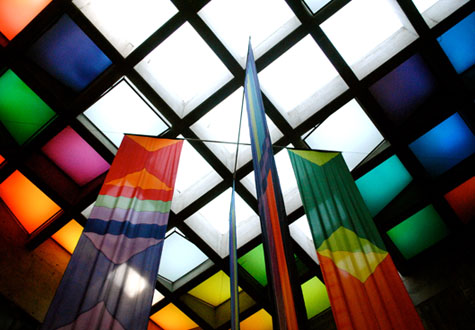We can’t fully guarantee that anyone would walk into the John Labatt Visual Arts Centre (figure 1) and say: “Wow, this is so beautiful!” Luckily, a reaction of immediate wonder isn’t exactly expected, since this space isn’t quite meant to be an ostentatious spectacle for viewing. However, Architect Raymond Moriyama did successfully design the building for its intended purpose. It is a space for visual arts students to work in and showcase their artwork. We wouldn’t want any distracting, overly flashy decor in here, and fortunately, there isn’t any. Let’s take a critical look into the practicality and aesthetics of the entrance and concourse of this space.
The curved stone facade and copper canopy of this building are representative of the mix between Modernism and the typical Gothic style of the University of Western Ontario’s earlier buildings (figure 2). The canopy, which is at an elevated angle, is a modern echo of tower-like structures of the older Gothic buildings, such as the clock tower of Middlesex College. The curved, concave facade of the Visual Arts Centre was meant to be complementary to the convex structure of Middlesex College, just west of the Visual Arts Centre, creating a harmonious relationship between the two structures (figure 3).
Past the glass doors of the Visual Arts Centre, you walk into a brightly lit foyer space with a grey ceramic-tiled floor. The moment you walk in, the space gives off a very grungy feel. Most of the materials used to construct this space are very industrial – cement, glass, and steel. A small staircase leads you down to the main concourse of the building, which is a long, airy corridor with studio and lecture rooms on either side. The floor is cemented and polished, and the bricked walls are painted white. There is also a gallery which overlooks this open concourse from the second floor. Embedded in the ceiling portion of this space is a giant, pyramid-shaped skylight (figure 4). The idea of natural light illuminating the space draws our attention to the fact that this structure has an organic element to it, and is thus connected to the natural world.
The exposed pipes in the ceiling and concrete walls are reminiscent of a factory in which works are being created and put together. Since this is a visual arts building, students are constantly working on projects and creating new pieces. The bare, white walls work really well in allowing for these pieces to be displayed without distraction. The concept of leaving certain elements of the skeletal structure bare was canonized by Modernist Architect Le Corbusier with his decisions to leave internal brickwork and concrete exposed. Thanks to Le Corbusier’s archetype, the exposed piping is also serves as the perfect platform for the hanging of any sort of stringy or webbed installations. The airy space, dubbed “the street,” of the concourse allows for an open walking space for viewers (figure 5), and provides ample room for installations of all sorts of eccentric shapes, sizes, and media.
Another very interesting aspect of this open space is the echoing of voices that is generated at the slightest whisper. There are a couple of aspects that are not immediately apparent; these echoes are a reflection of the vastness, and almost limitless potential of the realm of art. They also reflect a very positive take on art, an almost boomerang effect – you receive the same amount of joy from your completed piece as the hard work you put into it.
One aspect that is a bit off about this space is the sensor lighting that is activated in the evening. I mean, sure, we’re saving energy by turning on the lights only when someone walks in. But, imagine walking into the building in the late evening to work on a project, only to be alarmed by the lights suddenly turning on – reminding you that you’re the only person in this big, deserted space. It wouldn’t be the most comforting experience. Alongside being environmentally friendly, perhaps it would have been beneficial to take into consideration the eeriness of walking in here late at night.
The design of the entrance and concourse is very much in line with a Post-War Modernist aesthetic. This Modernist aesthetic is a very practical one – there is no useless jargon. Elements like visible electric cables are included, making them readily available for repair and change. In Interior Design since 1900, Anne Massey describes the Quickborner Team’s Modernist style office as being ‘built around traffic flow, rather than rigidly defining work hierarchies.’ Large, open spaces were divided up by fabric-covered screens, leaving the office space’s arrangement easily pliable, and inexpensive to put together. The design of the John Labatt Visual Arts centre is built on the same principle of practicality. The walls and ceilings are not plastered for a fine, finished look. It would cost a fortune to tear those down to make a repair, and then have to plaster them again. In all honestly, though, being so practical won’t always give you the most attractive outcome. The metal crossover staircases speak for themselves. On the positive side though, these staircases are highly durable and are able to withstand large amounts of pressure. The colour scheme, also very much a reflection of the Modernist aesthetic, gives the dullness of the industrial look some liveliness, as well. The combination of muddy colours with bright colours is a signature of the Modernist colour palette, and is seen in this interior with the red railing, and grey ceiling and floors (figure 6).
The simplicity of this space leaves people feeling like they can walk in comfortably and get started on their work; they can enter in their working clothes and not have to worry about keeping up with the ostentation of the building. All in all, the John Labatt Visual Centre entrance and concourse is successful in convincing the public that they are walking into a workshop space.
|













